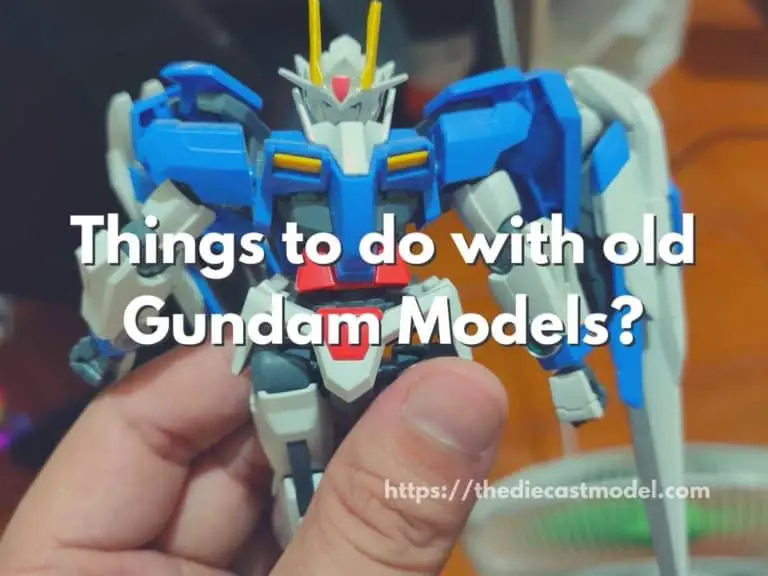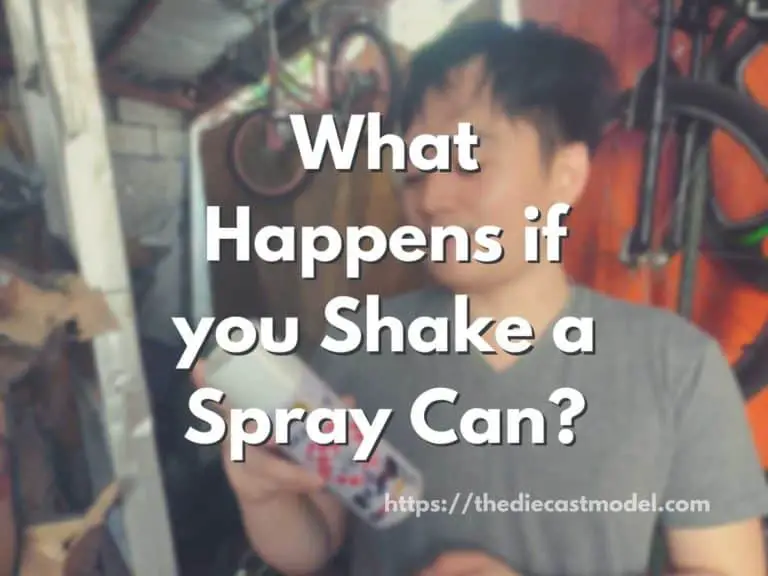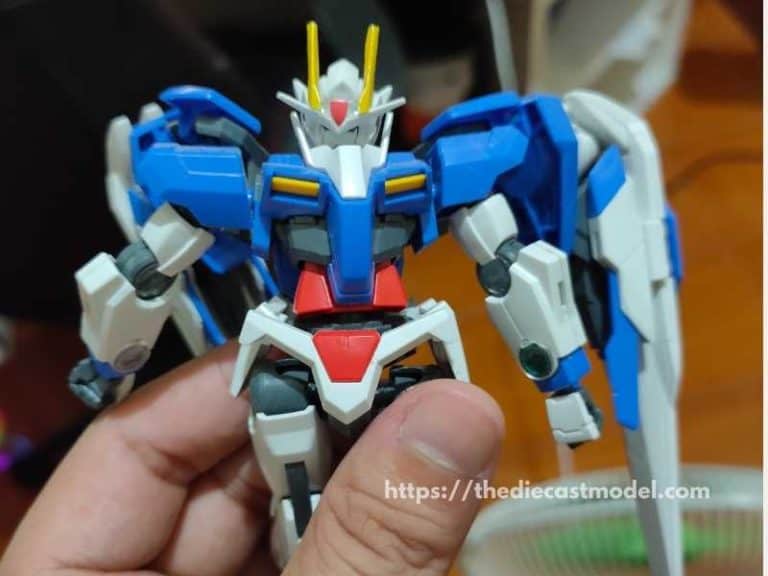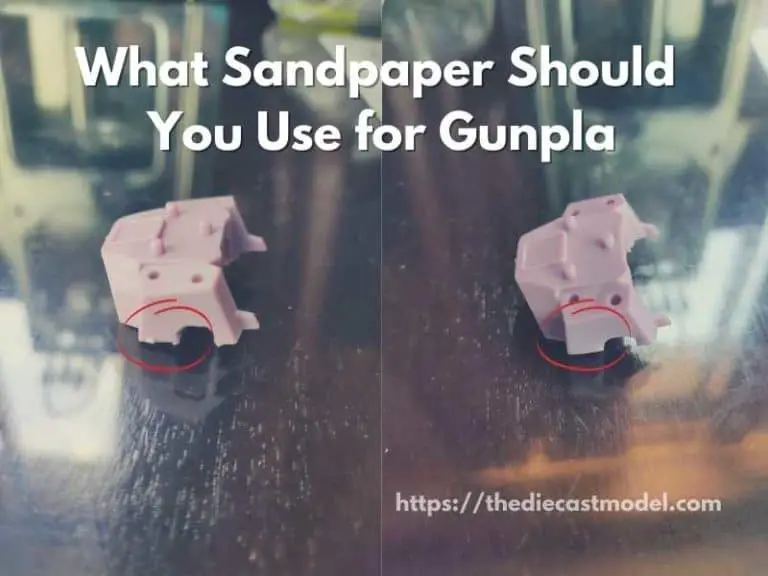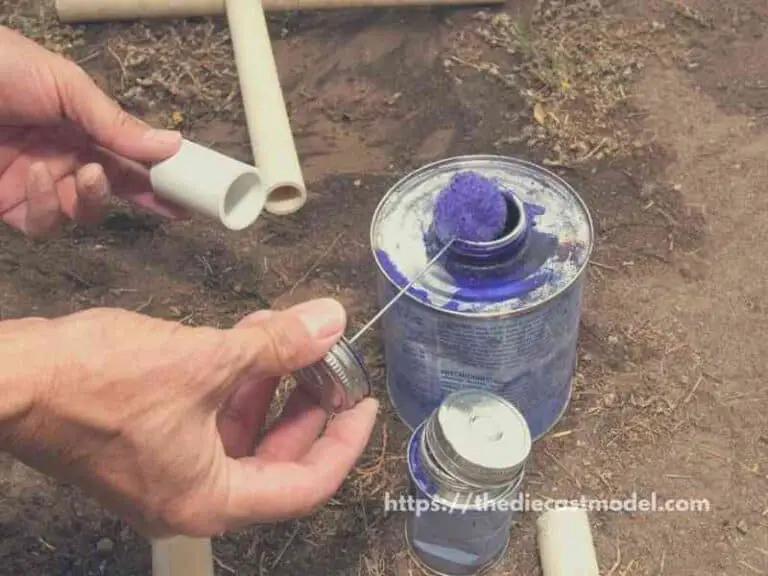Nail Polish Remover: Suitable for Plastic Models?
One of the strongest cleaning agents a person can use in cleaning models is nail polish removers or acetone. Acetone is a strong solvent that can easily remove dirt on surfaces. However, is acetone safe to be used on plastic models? Let’s find out.
In general, you should not use nail polish remover on plastic models. Although nail polish remover is a good cleaning agent to dust and dirt, plastics, particularly polystyrene, are soluble in acetone. This means nail polish removers can discolor or even melt plastic models.
In this blog post, we will explore the properties of acetone and if it can melt plastics. We are going to talk about what plastic is resistant to acetone. Furthermore, if you’ve decided to use acetone to clean your model, then I prepared a simple guide to prevent errors when using it. Lastly, I talked about the process of dipping the models into a cup of acetone if it is viable or not.
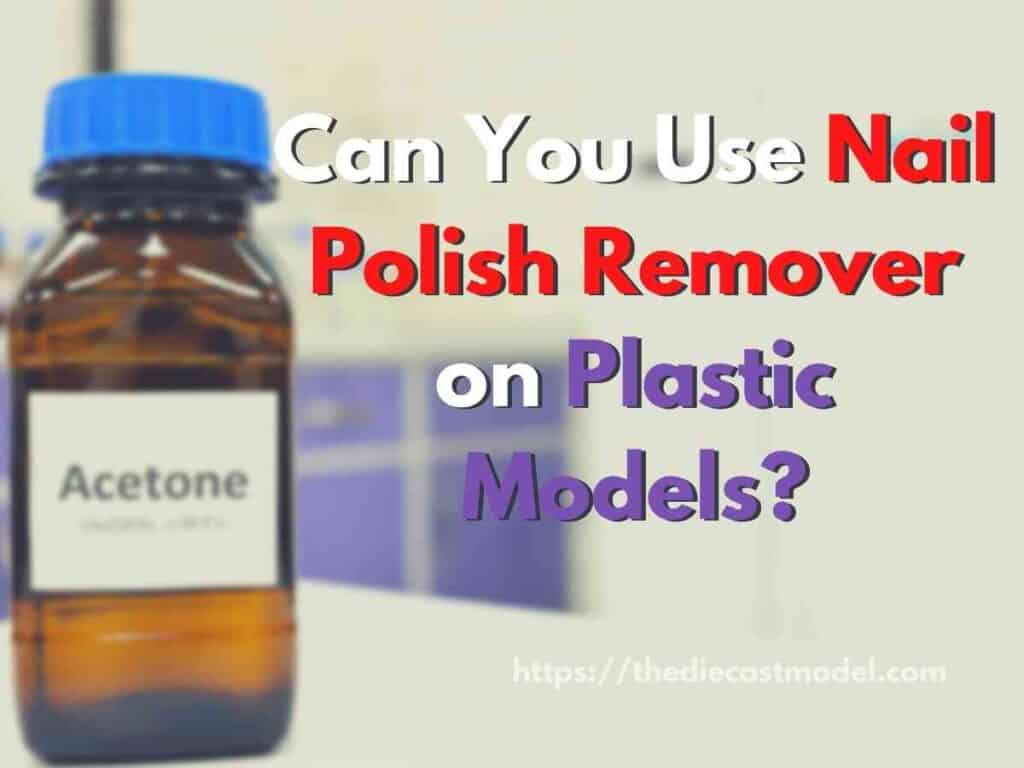
Can You Use Nail Polish Remover on Plastic Models?
Plastic surfaces, particularly those that are textured, can become dirty over time.
You can prevent intense build-up by cleaning the plastic often to eliminate even the slightest layer of dust, dirt, grease, and other debris.
Acetone is a solid chemical substance that is dissolvable and can remove surface contaminants—acetone, due to its rare characteristics helpful in removing paint or adhesive stains.
However, take note that you should continuously test the cleaning strategy on a particular area of your plastic model, so you will receive better results and avoid acetone degradation.
It has been advised not to use acetone on already painted plastic models, as acetone will eliminate varnish and paint.
Polystyrene, or rigid plastic, is indestructible and has an enduring period of usability.
Polystyrene, or the plastic used in models, has been involved in manufacturing, even on mannequins, for roughly two decades.
Presently, most plastic models are injection-molded in polystyrene, and the parts are glued together, usually with a plastic solvent-based adhesive.
When acetone comes in contact, the polystyrene chains self-destruct, which takes it to the bottom of the preference list.
Some manufacturers put acetone in a special plastic called polyethylene. However, this is rarely used on plastic models.
If you want to try using acetone on your plastic models, it is recommended to try it on a small surface. However, I would always advise against using it to clean plastic models.
Is Nail Polish Remover Safe on Plastic?
As a general rule, nail polish remover is not safe for plastics. Nail polish removers are considered natural solvents to polystyrene, one of the common plastic used in toys and products. However, some plastics are resistant to acetone, but they are rarely used.
No matter what domain it is, safety comes first.
Since nail polish remover is a solvent, so the short answer is NO.
However, some plastics are solvent resistant (or at least have a minor effect on exposure.
But that type of plastic isn’t what is mainly used. It may melt it, discolor it, etc.
Plastics that are safe for acetone are fluoroplastics, polyethylene, and polypropylene (Tefzel, Teflon, etc.)
Acetone can migrate through thin polyethylene (think baggie), so over time may disappear if stored in a container made of it.
Will Acetone Damage Plastic Models?
Generally speaking, acetone damages plastic models. This is because most plastic models are made out of polystyrene, which is soluble in acetone. However, though rare, some models are made with polyethylene which is resistant to acetone.
Acetone is a naturally occurring organic compound created in the human body during metabolic cycles where fat is broken down into energy.
Acetone is likewise produced and used as a solvent, commonly used in paint thinners, epoxy, and nail polish removers.
Due to its corrosive properties, you ought not to put acetone on plastic or other substances that may be sensitive to its effects.
Acetone is the vital part of nail polish or nail varnish removers commonly found in the market.
It is not a safe component to be applied to soft plastics. They’re usually sold in metal containers for a reason.
The acetone will damage the plastic’s surface by softening and smearing it or completely dissolving it.
But many companies do sell acetone as nail polish remover in plastic containers made of high-density polyethylene.
The material makes a difference.
Acetone solvent, no doubt a better solution for spot cleaning models because it vanishes quickly.
Right now, we will be talking about using nail polish remover on models. First, we need to give some insights on nail polish, the advantages and disadvantages of using it. Lastly, how to use acetone properly to prevent any damage to your models.
Nail Polish Remover Properties
Nail polish and other paint spills are hard to eliminate from most surfaces, including Plexiglass, linoleum, and plastic surfaces.
Nail polish spreads fast and dries quickly.
When you are performing removal of nail polish from plastic surfaces, you should perform carefully so the plastic surface beneath the polish is not damaged.
Once the nail polish is removed from the plastic surface, clean the surface with a non-abrasive solution to remove any polish residue and dirt.
The compound makeup of plastic is the fundamental determining component when it comes to suitability.
Nail polish removers, in general, are based on acetone which is a big NO for plastics like polystyrene, PVDF, PVC, cast acrylic, etc.
There exists another type of nail polish remover, which is non-acetone-based.
You may utilize nail polish removers on hard plastics, but they will damage plastic models of cellulose-based plastics. And surprisingly, minor damage spoils the whole look.
Acetone Holding Effects
It’s up to you to put acetone into a cup along with your model, but it will still dry up in no time.
In that case, make sure that acetone solvent does not destroy the cup.
The only way to hold acetone is to keep it in a metal container or plastic cup.
Acetone has such properties that it can eat paper, Styrofoam cups, thin plastics.
Also, it can make glue a gel-like substance for a short time, breaking down its molecules. Then, if you can’t remove the part quickly, the bond will dry back into place.
Advantages of Using Nail Polish Remover on Models
- One of the best substances for removing dirt from models
- Nail polish remover provides almost no downtime before being able to prime on account of fast dissipation.
- Nail polish remover requires less time before paint and glue are removable than the other two substances here.
Disadvantages of Using Nail Polish Remover on Models
- Nail polish remover requires ventilation.
- Nail polish remover dissipates rapidly when not in a fixed holder.
- Nail polish remover dries quickly alongside any glue it has weakened. It’s principal to move a model from acetone to cleaning as fast as possible.
- Nail polish remover is highly flammable
It is essential to use acetone cautiously since it is highly combustible, and the vapors can easily travel from one room to another, even though they are heavily weighted.
The molecules can cause fire or explosion when they come in contact with any open flame.
For this reason, acetone ought not to be utilized around chimneys and other danger zones.
Using acetone on plastic surfaces could lead to leaks and potential hazards if the substance travels to an area with an open flame.
How To Properly Use Acetone in Cleaning Models
Step 1: Soak a clean cloth in acetone.
Step 2: Rub the cloth over the outer layer of the plastic until it shows up and feels clean or until you eliminate as much of the dirt and build-up as could reasonably be expected.
Step 3: Dip a toothbrush into the acetone.
Step 4: Brush the acetone-soaked toothbrush over the plastic surface until it is perfectly clean. Work the acetone into the crevices and the finished surfaces of the plastic.
Step 5: Rinse the plastic with clear water and dry it.
Will Acetone Damage ABS Plastic?
As a general rule, acetone or nail polish remover can damage ABS or Acrylonitrile Butadiene Styrene plastics due to their solvent properties. Thus, it is not recommended to use acetone on ABS plastics. Cleaning ABS plastics with soap and water is better than using acetone.
Acetone can solvate a wide variety of polymers due to the polar protic solvent activity.
To bond the plastic polymers to the glass, these solvents, such as acetone, make a dilute ABS solution.
The solution uses intermolecular forces complexion to complete this bonding process.
Does Acetone Melt Plastic Cups?
Acetone is a strong solvent that can melt plastic cups. This is because acetone dissolves most plastics, including polystyrene, which is the principal plastic used in the production of plastic cups. That means, scientifically speaking, with time, acetone can melt and destroy a plastic cup.
If you plan on dipping your models into acetone with a plastic cup, then it’s a bad idea.
Acetone is a special solvent for this particular plastic, and that’s why a few drops of acetone that you put inside the cup can destroy the cup.
Thus, it is not advisable to do so.
However, I also know that acetone is an excellent way to clean models, but it is a strong solvent. So make sure to be careful when using them.
In short, nail polish remover is used for plastic models should be handled with care.
What’s next? If you’re interested in plastic models, did you know that you can use nail polish in painting them? Nail polish provides cheaper and stronger paint that you can use in painting models. If you’re interested how you may check this blog post: Can you use Nail Polish to Paint Models?

“Only the things I love”
thediecastmodel.com is reader-supported. When you buy through links on the site, I earn an affiliate commission.
So, here are the things I love when taking care of my Diecast Models.
Cleaning the Models
The first we are going to talk about is cleaning the models.
Removing Dust
- Air Brush – For me, this is the best since it not just removes dust but you can use it in painting/clear coating.
- Air Duster – This is a good alternative to Airbrush
- Normal Brush – If you are short on budget, you can use a normal brush. However, make sure that the brush has soft bristles because there are some hard brushes than can cause scratches. That’s why I recommended a good brush that can do the job properly.
Cleaning and Shining Hacks
Well, here are some of my cleaning hacks for removing scratches, oxidation, and so much more.
- Removing Decal Adhesive – Use Goo Gone on those hard-to-remove decal adhesives. It works fast and works like charm!
- Waxing and Polishing – Here is something a lot of people don’t know. Waxing protects the clear coat and paint while polishing shines the model. Instead of buying it separately, use a 2 in 1 to save money. Get this instead.
- Beginner Wax – The wax I recommended earlier is good and provides the best results based on my experience. But a beginner might have a problem especially if they’re not good at applying wax. Solid wax reaching hard to reach surface can be hard to remove. You have two choices here. One is to use a qtips to reach those surfaces, another is to use a liquid wax I recommended.
- Cleaning Wheels, Rubber, Plastic – Do not forget that rubber and plastic surface are quite different, especially in the cleaning process. Just wiping it down won’t do the job. That’s why I use Meguiar’s Vinyl and Rubber Cleaner and Conditioner. Works like charm!
- Make the Wheels Shine! – Making our models look good won’t be complete without tiny details such as shiny wheels! Do not forget this because however small this is, the difference can be as big as night and day.
- Remove Scratches Easily – Tiny scratches are not the end for your model. Here is a simple trick I’ve been using to make my models look scratch-free even without repainting. Use T-Cut.
Painting the Models
Painting Tools
Make sure when you paint models, have these ready.
- Tape – A tape is important if you are painting a straight line. Furthermore, it will prevent your paint to scatter on other parts. I recommend Tamiya Tape since it is really made for models. Furthermore, they stick really well preventing paint splatters.
- Brush (Beginner) – Find a good set of brushes to paint your models. Of course, you can opt for an airbrush but it’s quite expensive.
- Airbrush (Intermediate/Expert) – This will yield a significantly better result than an ordinary brush because you can easily spray the paint evenly. I recommend this if you know what you’re doing.
- Stand(Optional) – Stands are good because it can be hard to manually hold the models while painting. It is optional but in my opinion, the price is well worth it for the comfort it gives.
- Drop Cloths – Drop Cloths will protect your surroundings from the paint.
- Primer – The most common beginner mistake I see is painting models without any Primer. A primer will prevent imperfections such as bubbles or paint not sticking to your models. It is a small price to pay for quality results.
- Clear Coat – A clear coat will protect the paint of your models. This will make the paint last longer. Also, it is the one responsible for making your models shine.
Paints
Of course, you can’t do painting properly without paint. So here are the ones I recommend.
- Acrylic Paint – Good for beginners because it dries quickly. However, it doesn’t produce results as good as enamel paint.
- Enamel Paint – Provides a good quality finish and longer-lasting paint. However, it takes longer to dry and requires expertise to use.
Model Maintenance
Model Storage
- Simple Wood Cabinet – While it doesn’t let you display your models, wooden cabinets are good storage for these models. For one, they are not heat conductors which means that the temperature inside will remain constant and remain cool. Furthermore, they prevent light from reaching the models which can cause oxidation.
- Clear Cabinet with Lock – If you want to display your models, then I recommend this. It closes so dust won’t easily get to your models. I also recommend you don’t put more than 1 model in each compartment since metals are good conductors of heat.
Model Photography
So you want to show off your models to others? Well, I got you covered.
Here is my beginner-friendly model photography tutorial that teaches everything from taking pictures to the editing process.
You will also see me doing hands-on photography in that tutorial.
Here is the link: How to Take Pictures of a Diecast Model or Model Kit | Helpful Illustrated and Video Guide

